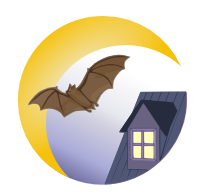Signs indicating the presence of bats in a house
The presence of noise
- Various noises such as scratching or squeaking.
The presence of feces, commonly referred to as GUANO
- Bat guano is segmented, elongated and brittle
- It becomes powdery when crushed
- It gives off an unpleasant smell when the maternity colony is large
- Guano often becomes stuck to walls, where the bats enter their colony
- Attention - Bat feces can cause histoplasmosis, which is a pulmonary infection that results from a fungus found in guano. Generally, this fungus does not survive in hot and dry attics; however, in order to avoid any risk of contamination, it is recommended that you carefully follow certain preventative measures
The presence of urine
- It crystalizes at room temperature
- It makes the area where it has been dropped seem powdery
Tips for cohabitation
- Bats do not cause the same level of damage as the rodents that can live in our houses. Bats only enter through pre-existing holes and often occupy non-utilized areas, like roof spaces. The main nuisance associated with bats is their guano. To avoid the problems associated with guano, you can place a plastic tarp on the area below where they are roosting early on in the spring. This way, you will be able to clean up after them more easily at the end of summer when the bats have left to spend winter in a hibernaculum.
- There is no reason to panic if you think there are bats living in your house because the probability of one of them having rabies is very low. Like most mammals, bats can contract the rabies virus, but only 1% of them are infected. However, to be careful, you should avoid contact with bats in order to prevent becoming infected with rabies, which is lethal to all mammals, including humans. It is important to realize that bats found on the ground have a greater chance of having rabies. Therefore, it is important to never touch a bat bare-handed, even if it is dead click for more info.
- If a colony of bats has settled in your attic, it is important to caulk all holes and cracks between the attic and the lived-in areas of your house.
- If a bat enters the living-space of your house, never touch it bare-handed. Close the door to the room and open the windows and screens. It should leave by itself. If this does not work, follow the following guidelines. Next, find the hole where it likely entered the house and caulk it.
- Do not go into areas inhabited by bats while they are there. In order to see them, wait for them outside and watch for them to leave after the sun has set. To confirm that you have a maternity colony, follow this protocol. If you perform a count of the number of bats in the colony, you can submit the data to us here
- Make sure that your pets are vaccinated against rabies. This is a basic but very important rule, especially if there are bats are living in your home. Rabid bats are often found on the ground, which makes it more likely that your pets will come into contact with them. Pets also require booster vaccines for rabies. Consult your veterinarian for further information.
- Another way to live with bats on your property is to set up bat houses on your property. If bat houses are installed near the building where the bats lived, the colony will often move to the bat house. For more details, see "Setting up a bat house"

